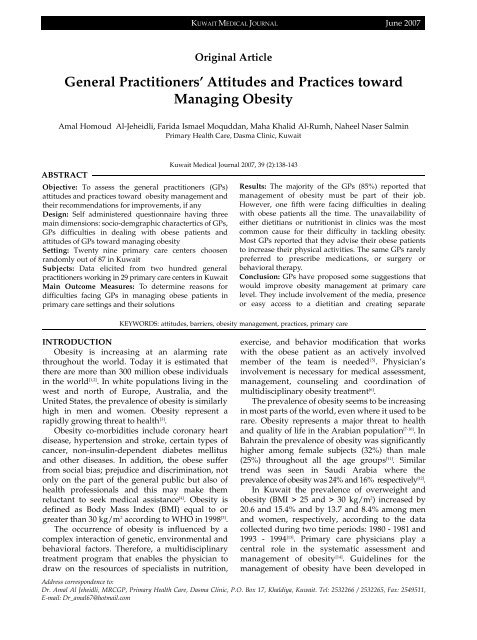Vol 39 # 2 June 2007 - Kma.org.kw
Vol 39 # 2 June 2007 - Kma.org.kw
Vol 39 # 2 June 2007 - Kma.org.kw
- No tags were found...
Create successful ePaper yourself
Turn your PDF publications into a flip-book with our unique Google optimized e-Paper software.
KUWAIT MEDICAL JOURNAL <strong>June</strong> <strong>2007</strong>Original ArticleGeneral Practitioners’ Attitudes and Practices towardManaging ObesityAmal Homoud Al-Jeheidli, Farida Ismael Moquddan, Maha Khalid Al-Rumh, Naheel Naser SalminPrimary Health Care, Dasma Clinic, KuwaitABSTRACTO b j e c t i v e : To assess the general practitioners (GPs)attitudes and practices toward obesity management andtheir recommendations for improvements, if anyDesign: Self administered questionnaire having threemain dimensions: socio-demgraphic charactertics of GPs,GPs difficulties in dealing with obese patients andattitudes of GPs toward managing obesityS e t t i n g : Twenty nine primary care centers choosenrandomly out of 87 in KuwaitS u b j e c t s : Data elicited from two hundred generalpractitioners working in 29 primary care centers in KuwaitMain Outcome Measures: To determine reasons fordifficulties facing GPs in managing obese patients inprimary care settings and their solutionsKuwait Medical Journal <strong>2007</strong>, <strong>39</strong> (2):138-143Results: The majority of the GPs (85%) reported thatmanagement of obesity must be part of their job.However, one fifth were facing difficulties in dealingwith obese patients all the time. The unavailability ofeither dietitians or nutritionist in clinics was the mostcommon cause for their difficulty in tackling obesity.Most GPs reported that they advise their obese patientsto increase their physical activities. The same GPs rarelyp re f e r red to prescribe medications, or surgery orbehavioral therapy.Conclusion: GPs have proposed some suggestions thatwould improve obesity management at primary carelevel. They include involvement of the media, presenceor easy access to a dietitian and creating separateKEYWORDS: attitudes, barriers, obesity management, practices, primary careINTRODUCTIONObesity is increasing at an alarming ratethroughout the world. Today it is estimated thatthere are more than 300 million obese individualsin the world [1,2] . In white populations living in thewest and north of Europe, Australia, and theUnited States, the prevalence of obesity is similarlyhigh in men and women. Obesity re p resent arapidly growing threat to health [3] .Obesity co-morbidities include coronary heartdisease, hypertension and stroke, certain types ofc a n c e r, non-insulin-dependent diabetes mellitusand other diseases. In addition, the obese sufferfrom social bias; prejudice and discrimination, notonly on the part of the general public but also ofhealth professionals and this may make themreluctant to seek medical assistance [4] . Obesity isdefined as Body Mass Index (BMI) equal to <strong>org</strong>reater than 30 kg/m 2 according to WHO in 1998 [3] .The occurrence of obesity is influenced by acomplex interaction of genetic, environmental andbehavioral factors. Therefore, a multidisciplinarytreatment program that enables the physician todraw on the resources of specialists in nutrition,exercise, and behavior modification that workswith the obese patient as an actively involvedmember of the team is needed [ 5 ] . Physician’sinvolvement is necessary for medical assessment,management, counseling and coordination ofmultidisciplinary obesity treatment [6] .The prevalence of obesity seems to be increasingin most parts of the world, even where it used to berare. Obesity represents a major threat to healthand quality of life in the Arabian population [7-10] . InBahrain the prevalence of obesity was significantlyhigher among female subjects (32%) than male(25%) throughout all the age groups [11] . Similart rend was seen in Saudi Arabia where theprevalence of obesity was 24% and 16% re s p e c t i v e l [ y12 ] .In Kuwait the prevalence of overweight andobesity (BMI > 25 and > 30 kg/m 2 ) increased by20.6 and 15.4% and by 13.7 and 8.4% among menand women, respectively, according to the datacollected during two time periods: 1980 - 1981 and1993 - 1994 [ 13 ] . Primary care physicians play acentral role in the systematic assessment andmanagement of obesity [ 14 ] . Guidelines for themanagement of obesity have been developed inAddress correspondence to:Dr. Amal Al Jeheidli, MRCGP, Primary Health Care, Dasma Clinic, P.O. Box 17, Khaldiya, Kuwait. Tel: 2532266 / 2532265, Fax: 2549511,E-mail: Dr_amal67@hotmail.com
















